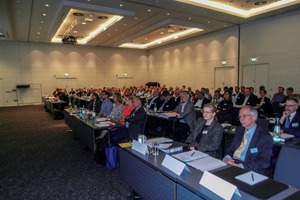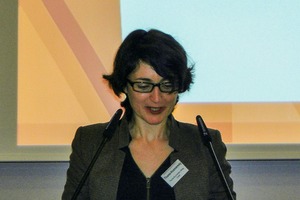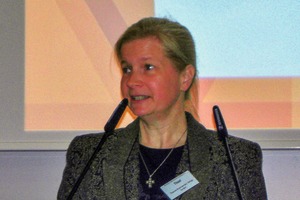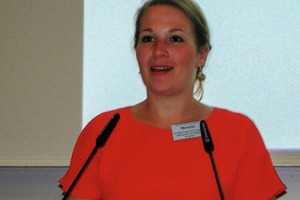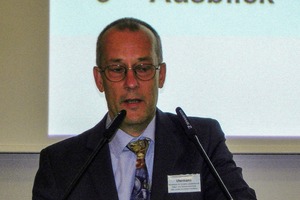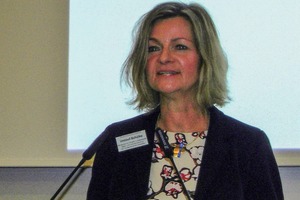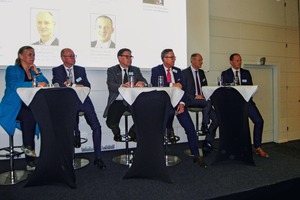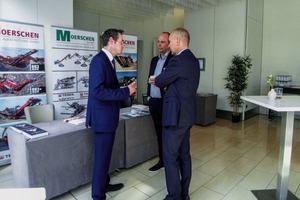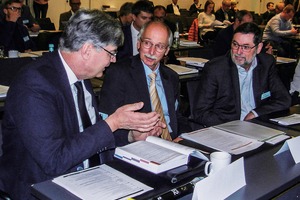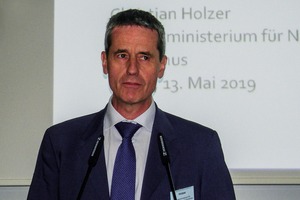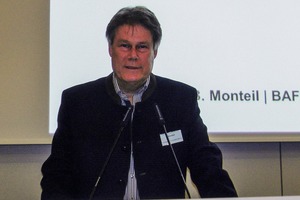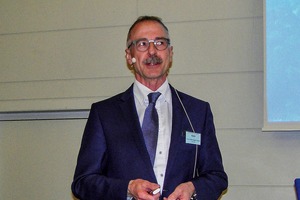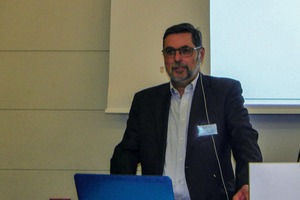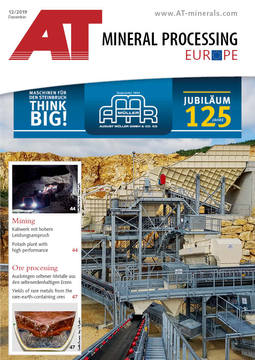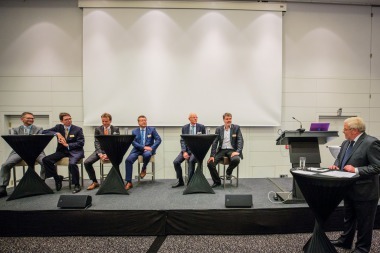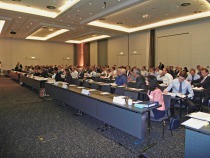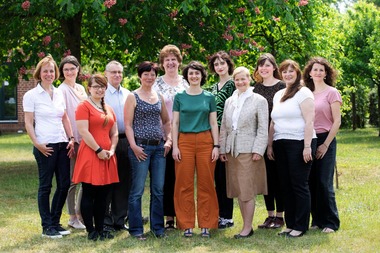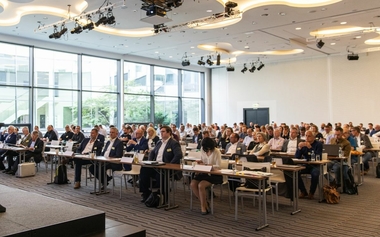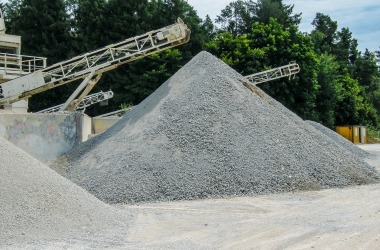Umbrella Ordinance: Hope – good things
take time?
take time?
In her introductory speech, Dr.-Ing. Stephanie Thiel, of VIVIS Verlag GmbH Neuruppin, the scientific coordinator of the conference, again provided a brief overview of the history of the MantelV and focused, in particular, on the activities which were aimed, more than a year ago, at the completion of the legislation: formation of the ad hoc work-group in May 2018, which was intended to submit a result after three months, the setting-up of two sub-work-groups (BBodSchV/EBSV), the founding of further sub-sub-work-groups – coordination and reaching agreements became ever more ramified and difficult. There are now around 300 proposals for changes requiring discussion and it is prophesied that conclusion of the MantelV should still be possible this year. Opinions from the recycling industry can be summarised as follows: Better a MantelV with weaknesses than none at all.
Renewed focus on the Umbrella Ordinance
As expected, the morning session of the plenary event on the first day of the conference was devoted solely to the Umbrella Ordinance, and closed with the panel discussion already mentioned.
Speaking this year on the status of the MantelV from the Federal Minister for Environment, Nature Conservation and Nuclear Safety, Bonn, was Dr. Gila Merschel, successor to Senior Government Officer Michael Heugel. The central content of her address focussed on the main points of criticism of the ordinance resulting from the preliminary deliberations concerning the Bundesrat (Federal Council) procedure. Following a short examination of the contents of the MantelV and its history, she emphasised the main point of criticism of the ordinance up to now, the concept of the EBSV. This is based only on limits for eluate, and not for solids. Major reroutings of waste flows toward landfills are therefore feared. The federal government’s commitment to the MantelV, formulated in the coalition agreement, is clearly stated, however. The agreement also grants to the federal states the possibility of introducing an exemption clause. This, however, applies only to stowing projects. Dr. Merschel then explained further procedure: continued consultation of the Federal Council, there being three possibilities: approval without change, agreement with conditions, and rejection of the ordinance by the Federal Council. If the MantelV is passed, it will come into effect one year after its proclamation, transitional provision for procedures already issued will continue to exist for eight years and an evaluation of the effects of implementation will take place within four years (criteria are currently being drafted).
Principal Undersecretary Prof. Dr. Jens Utermann, of the Ministry for Environment, Agriculture, Conservation and Consumer Protection of the Federal State of NRW, spoke on the Federal Soil Protection and Contaminated Sites Ordinance, and thus on the work of a sub-work-group of the ad hoc work-group. In this group, ten representatives of the environment ministers of the federal states have discussed the viable and the unclear motions. Dr. Utermann examined in details structural and content changes (terms and definitions, expanded scope of provisions for care and prevention of hazards/aftercare, requirements for sampling). The work of the BBSchutzV sub-work-group has been completed since June 2018. It is to be conclusively discussed, together with the results of the EBV sub-work-group (completed in the second quarter of 2019), in the ad hoc work-group on the MantelV at a special meeting of the heads of department of the environmental division before being debated in the Federal Council.
The deliberations by Petra Umlauf-Schülke, also of the Ministry for Environment, Agriculture, Conservation and Consumer Protection of the Federal State of NRW, Düsseldorf, were of equal importance. The sub-work-group had recently met for the final time to again review the points for discussion from the deliberations of the federal states on the EBV. The procedural status has not yet been completed, there were many proposals for changes, many of which command majorities; many do not, however, and many items remain unclear. The speaker examined several proposed changes of the total of around 260, assigning them to three categories: material evaluation criteria (~ 50 %), enforcement provisions and finalised specification of definitions, editorial matters, miscellaneous. She examined in detail a number of motions for changes which relate, inter alia, to the deletion of materials classes (e.g. hazardous-waste incineration ash), and also to their modes of installation, to recycled building materials and the limitations on their use, and to the change in minimum installation quantities. Other suggested changes concerned the obligation for documentation, notification and monitoring, and the expiry of categorisation as waste, to name but a few. The speaker garnered much praise for her frank and honest examination of the status of the EBV, which posited that the stipulation of solids limits was not necessary from a waste-management and soil-protection law viewpoint. The unanimous opinion of the discussion participants was that there are exaggerated requirements which would result in the reduced use of recycled building materials.
Panel discussion – Practical effects of the Umbrella Ordinance
The well-known journalist Joachim Mahrholdt, chairing the panel discussion, opened this round of talks with a quotation from Berthold Heuser: “There are two things you need to have endurance for: marathon running and the Umbrella Ordinance”, then introducing the participants:
Birgit Gehr, CEO, Blues Bay, Logistik Umwelt & Entsorgungs Systeme GmbH, Munich, Chairperson of Entsorgungsgemeinschaft Bayern e.V. and member of the Recycling Verband Bayern e. V.
Berthold Heuser, Holder of Procuration, REMEX Mineralstoff GmbH, Düsseldorf
Dr.-Ing. Klaus Mesters, Director, KM GmbH für Straßenbau und Umwelttechnik, Bochum
Dr. Tilmann Quensell, CEO of Otto Dörner Kies und Deponien GmbH & Co. KG, Hamburg
Dipl.-Ökon. Hans-Joachim Rauen, CEO of Hermann Rauen GmbH & Co. KG, Mülheim a. d. Ruhr
Michael Weiss, CEO of Johann Ettengruber GmbH, Dachau
The chairperson firstly noted that the production and acceptance of recycling products is, naturally, a subject close to the hearts of the participants, who were representing the construction, demolition and recycling sectors of the industry. Six representatives of the “lived out” circular economy were asked for their opinion on the MantelV, opinions to which the chairperson attached a large question mark.
In response, Dr. Quensell, as the representative of a service-provider for the metallurgical industry, took up the subject of slag and argued a clear opinion on this topic: “Slag is to be regulated in the MantelV. A standard provision throughout Germany is OK, at the moment we have a real patchwork, due to individual state sovereignty. Slags (primarily iron and steel plant slags) are to be excluded from the MantelV however. Some 5.5 t of this secondary raw material, for which only open installation is possible, are yielded every year. If this is prohibited, however, no recycling of 50 to 60 % of this material will be possible, and only landfill dumping, instead. The iron and steel plants will thus have problems, as well, at the same time, as the locations, which will be threatened with existential difficulties. In addition: existing landfill capacities are finite, landfill dumping is expensive, and landfill construction in the short term is not possible.”
Holder of Procuration Heuser pointed out the urgency of putting an end to votes and rounds of discussion. “It is high time that the marathon finally reach the tape. The law cannot be allowed to fail”, was his plea. Asked for her opinion on the effects of the MantelV on a small/medium-sized enterprise, CEO Birgit Gehr emphasised the associated planning certainty as the greatest benefit. “The MantelV has to come, for this reason. Great uncertainties exist at present. I perceive great potentials for achieving equality, and equivalence in implementation is necessary in this context.”
Dr. Quensell complained of the current problems in the marketing of substitute building materials (SBM), which is the result of the uncertainty caused to users by the incredible story of the MantelV. There must be clarity, he noted, on how an SBM needs to look to be used as a product. He emphasised the demand repeatedly expressed within the industry to oblige public and private contractors to use recycled building materials. “Next year, Hamburg will turn into a major construction site – so where does the rubble go? The longer we wait, the greater will be the uncertainty,” were Dr. Quensell’s closing remarks.
CEO Weiss questioned the practical applicability of the MantelV and opined that: “What actually happens on the construction site is being totally forgotten.” He, too, fears that it will be necessary to landfill dump more material. There is no demand for the RC 2 and RC 3 recycled building materials. The integration of the EBV into the MantelV should, actually, result in more recycling, but the opposite is to be feared.
This round of “statements” was followed by an appeal to the audience for a discussion. Of the numerous discussion participants, only a few can be quoted here:
Attorney Dr. Stede, environmental consultant, Landsberg/Lech, advocated quality criteria for some few pure RC building materials, since up to now there has been no market for anything > RC 1. She addressed an appeal to the federal government to formulate in Article 45 provisions implementable in practice. Certainty and, above all, investment certainty for companies, is necessary, she affirmed.
Holder of Procuration Heuser restated the fact that the industry is involved in the procedure. For this reason, it is also difficult to “adjust” fundamentals (RC 2, RC 3) retrospectively. The recycling industry associations have uniform expectations, and these are: promote recycling. The MantelV is a necessity and the laments coming from the construction industry are not understandable.
Dr.-Ing. Jörg Demmich, of Knauf Gips AG, Iphofen, drew attention to the fact that the BDE and BDI electrical and engineering associations have unanimously spoken out in favour of the MantelV. The evaluation phase of four years is, in their opinion, too long, however, and two years should be sufficient to determine what routes the materials are taking.
Dr.-Ing. Heinz-Ulrich Bertram, Principal Undersecretary (ret.), Hildesheim, opined: Everyone is in favour of standardised provisions, but the picture is totally different in the case of stowing and investment certainty. And standard regulations throughout Germany are necessary, since otherwise material displacements can be foreseen, particularly in border areas.
The industry representatives are in agreement on many points:
Clear boundary conditions are necessary, rather than dependency on individual decisions by the authorities.
If recycled building materials are really wanted, a mandatory provision will be necessary, i.e., the obligation to use RC 2 building materials must be incorporated into the MantelV.
The industry needs the support of the political world, there should at least be material-neutral invitations to tender, the partial use of RC building materials could, for example, be stipulated.
Legal provisions in neighbouring countries and Europe
The afternoon session was devoted to this subject and began with a paper by Dipl.-Ing. Christian Holzer, of the Austrian Federal Ministry for Sustainability and Tourism, Vienna, who spoke on experience gained with the Austrian Recycled Building Materials Ordinance and with the requirements concerning excavated materials in accordance with the Austrian Federal Waste Management Plan of 2017. In accordance with these two directives, the valorisation of waste from construction and demolition activities is to be governed holistically in Austria. The fundamental principle is recycling-orientated demolition, and the training of inspectors expert in demolition has been introduced for this purpose. The speaker reported on details such as the problem area of man-made mineral fibres, RC building materials with the corresponding quality-assurance system and the recycling of iron and steel plant slags. Other core items include on-site recycling, the definition of clear boundary conditions, the re-use of building components, Design for Recycling, composite materials and the exemplary function of public authorities. His conclusion: Recycling yes, but not at any price.
Experience with implementation and the effects on mineral material flows were examined by Dr. phil. nat. Michel B. Monteil, of the Swiss Federal Office for the Environment, Ittingen, in his deliberations on Switzerland’s Waste (Avoidance and Disposal) Regulations (VVEA, 2015, amended 01/2019). Switzerland, it is true, does not have a Closed Substance Cycle and Waste Management Act, but is nonetheless continuously moving toward the closed cycle “circular economy”. This extends, inter alia, to the introduction of a duty of recycling, with a transitional period of ten years. As in Germany, the greatest part of the waste occurring is also made up in Switzerland of excavated and demolition materials. This speaker discussed this in detail, stating that only around 25 % of the necessary construction materials can be met using recycled products. No recycling rates are stipulated for the construction sector, due to the fact that the ecological optimum is frequently disregarded (100 % recycling often means a high environmental burden). Waste avoidance is, in future, to be of central importance. In closing, Dr. Monteil emphasised that Swiss waste management will, in the next few years, evolve into a resources management industry on the basis of the VVEA. One example of this was examined by Dr. sc. Elmar Kuhn, of the Swiss Office of Waste, Water, Energy and Air, Zurich, in his address entitled “The Canton of Zurich as a resources storehouse of the future”, covering urban mining of construction waste. No less than 2.7 million t/a of building waste is yielded in the Canton of Zurich. A plan of action incorporating the targets of conservation of resources, ecological and energy efficiency, optimised assuredness of disposal, and the protection of the environment and the populace, has existed since 1997. These aims are to be accomplished using tailor-made instruments for the valorisation of building waste, implementation in the demolition and modernisation of high-rise buildings and in the disposal of waste asphalt in underground engineering.
Also not to be forgotten is the excellent overview paper presented by Prof. Dr.-Ing. Thomas Pretz, of RWTH Aachen University, entitled “High-quality recycling in research and practice”. This speaker very realistically and critically questioned the status of recycling in the construction sector: “Downcycling is not needed, instead, high-quality recycling is required and expected. There have been many extravagant promises on this, but many of the technical solutions proffered have then gone under and not achieved access to the market. A certain disillusionment has thus set in. But: Good things take time.” Prof. Pretz examined the aims of recycling (replacement of primary resources) in as much detail as high-quality recycling by means of appropriate demolition and cited here the example of RC concrete. Here, he stated, technical solutions have been known for fifteen years, suitable products have been feasible thanks to standardisation, relevant codes of practice and quality assurance by means of manufacturers’ declarations exist, but these have nonetheless been able to penetrate the market only to a slight extent. This, he affirmed, is the result, inter alia, of the limited availability of RC resources for the production of constant quality products. Much, he stated, has been achieved in the field of research, but has earned only little appreciation.
Specialist sections
As in the previous events, the papers for the second day of the conference were presented in the context of four parallel sessions and focused on scientific and technical topics. With a total of thirty-nine addresses, a comprehensive and highly interesting programme of papers awaited the participants, divided into the following sections:
Residues from the incineration of waste
Metallurgical by-products
Building waste
Landfills and mining stowing
Not only technical process descriptions were examined, but also scientific investigations, projects, experience of approval procedures, and also operating experience. A few speakers are mentioned and outlined in brief by way of example below.
1 Residues from the incineration of waste
Here, the focal topic was Ecotoxicity HP 14 (e.g. Dipl.-Chem. Hermann Nordsieck et. al., bifa Umweltinstitut GmbH, Augsburg). Washing processes for ash were also the subject of discussion, however (e.g. Dr. Jan-Peter Born, N.V. HVC Alkmaar/Netherlands). The potentials and limitations of wet preparation of fine waste-incineration plant (WIP) slags were discussed by Jonas Böhnke, M.Sc., of Sepro Mineral Systems Corp., Langley/ California, while Prof. Dr.-Ing. Rüdiger Deike, of the University of Duisburg-Essen, examined the question of “Can the mineral fraction of the fines fraction of WIP slag be used in the cement industry?”. The papers by Dr. Stefan Schlumberger, of the ZAR Centre for Sustainable Management of Recyclable Waste and Resources, Hinwil/Switzerland (Recovery of metals from fly ash) and by Dipl.-Ing. Saman J. Setoodeh, Vienna University of Technology/Austria (Fly ash as a store of thermodynamic energy and CO2) were both devoted to the topic of fly ash.
2 Metallurgical byproducts
The central topics in this section were innovative methods and valorisation routes for slags from the iron and steel industry, the recycling of problematical steel scrap, the recovery of critical and rare metals from slags, and also the recycling of metal-containing sludges. The following may be mentioned by way of example: Dr. Alexander Fleischanderl, Primetals Technologies Austria GmbH, of Linz: “Future-orientated methods and valorisation routes for slags from the iron and steel industry”. The development status of voestalpine’s pilot plant for dry slag granulation to produce granulated blast-furnace slag and incorporating the recovery of waste heat, and also a new process for the production of cement clinker from converter slag with simultaneous recovery of metal, were discussed, and the mobilisation of hydraulically active phases in LD slags via the production of ultra-fine material reported on. Also of interest was the paper by a consortium of speakers consisting of Dr. Bert Bult, Purified Metal Company in the Netherlands) and other authors from Non Ferrous Küttner GmbH & Co. KG, Essen, and RWTH Aachen University: “Elegant recycling of precarious steel scrap – a new process”. Due to the large quantities of contaminated steel scrap (contaminated principally with asbestos, but also with Hg, Pb, Cd, dioxins and PCB), the researchers perceive a great potential for recycling with simultaneous extraction of the contaminants. The commercial application of this concept should be worthwhile, in view of the enormous quantities of contaminated steel scrap occurring globally and the growing need to recover them.
3 Building waste
The range of topics covered in this section was, as expected, very diverse, and extended from experience in implementation of the Commercial Waste Regulations in the construction sector (Dipl.-Ing. Sandra Giern, BDE e. V., Berlin), via the assessment of the freedom from asbestos of building waste and building materials by means of a standard, universal limit (Dr.-Ing. Jörg Demmich, Knauf Gips KG, Iphofen) and the handling of tar-containing highway-construction waste (Principal Undersecretary Martin Kneisel, Baden-Württemberg Ministry of the Environment, Climate Protection and the Energy Sector, Stuttgart), up to and including the recycling of man-made mineral fibres (Assistant Prof. Dr. rer. nat. Daniel Vollprecht, University of Leoben/Austria). In view of his rich store of experience as a Principal Undersecretary in the Ministry of the Environment in Lower Saxony and of the never-ending discussions concerning the MantelV, the deliberations of Dr.-Ing. Heinz-Ulrich Bertram, Hildesheim, on the subject of “Are we oversleeping the future? – An interjection for the recycling of mineral waste”, were awaited with justifiable anticipation. He critically examined the upcoming Substitute Building Materials Ordinance (EbV) and outlined the many deficits which even now can be expected with certainty. As he noted, there are no answers to many relevant questions and no solutions for current problems in the disposal of mineral resources and in the use of substitute building materials produced from them. These deficits can no longer be rectified in the Bundesrat (Federal Council) procedure for the MantelV. As Dr. Bertram remarked: “Up to now, the time has not been used to elaborate solutions and it can be foreseen that the omissions outlined will result in significant problems in implementation and will thus hinder necessary investments.”
4 Landfills
Taking due account of the again growing importance of landfills, a total of ten papers this year addressed this subject. The enactment of the MantelV will inevitably result in renewed needs for more landfill capacity. The long planning and construction times will mean that landfills will have to be reconstructed, expanded or reactivated. Logically enough, the need for landfills and for expansion of capacity was discussed (by, among others, Dipl.-Verww. Hartmut Haeming, Interessengemeinschaft InwesD, Cologne: “How is the assuredness of disposal for mineral waste developing, with an examination of the landfill situation in the federal states of Germany?” and Sabine Haase, Remex Mineralstoff GmbH, BS Cologne: “Reactivation of the abandoned DK II landfill Haus Forst”), as well, on the other hand, as underground engineering and mining stowing (e.g. Dipl.-Ing. Susanne Polter, Max Aicher Umwelt GmbH, Schkopau: “Stowing of mineral residues at the former potash mines in Bleicherode and Sollstedt”). Prof. Dr. mont. Robert Galler, of the University of Leoben/Austria, examined the results of an extensive national and a European research project into “Excavated material from tunnelling – Waste or mineral resource?”.
Within the Landfill Aftercare and Decommissioning series of papers, Prof. Dr.-Ing. Gerhard Rettenberger, of Ingenieurgruppe RUK GmbH, Longuich, spoke on “Passive gas emission in aftercare against the background of the new VDI code”, and M.Sc. Bastian Küpers, of the University of Leoben/Austria on the use of sensor-assisted methods in landfill mining.
Concluding remarks
Thanks are due to the organisers and their programme committee for an interesting, balanced agenda and excellent organisation. The placing of the panel discussion in the morning session of the first day of the conference, introduced last year, itself proved to be extremely successful, as was apparent, not least of all, from the avidity of the panel members and the audience to continue discussing.
Despite the fact that the never-ending story of the MantelV still remains unfinished, the inclusion of this subject and the detailed examination of the current status from both the political and official viewpoint were very informative for the participants, as were also the opinions expressed by the representatives of commercial companies.
All in all, the Berlin “Mineral Byproducts and Waste” conference can be considered a highly successful event and it remains to be hoped – and here, one can only join the ranks of the industry representatives in the panel discussion – that it will be possible next year to report on initial experience with the MantelV.
The majority of the papers included in the conference agenda can be found in “Mineralische Nebenprodukte und Abfälle 6 – Aschen, Schlacken, Stäube und Baurestmassen” – Thomé-Kozmiensky Verlag GmbH, Neuruppin 2019, ISBN 978-3-944 310-47-3.
The next Berlin “Mineral Byproducts and Waste” conference is to be held in Berlin on 18 and 19 May 2020.
Autor/Author: Dr. Brigitte Hoffmann, Consulting, Kreislaufwirtschaft/Umweltschutz Oberschöna/Germany

